Derby's Heritage Part 28 - London Road
w/e 29 April 2012
All this week's pictures were taken
with a Kodak DX6490
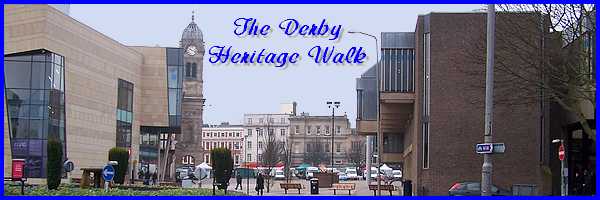
We left the previous part of this series by walking
from the "Railway Village" area of Derby along Liversage
Walk and turning towards Trinity Street and we resume this part
near Trinity Street's junction with London Road, the road we
will follow back into the city centre.
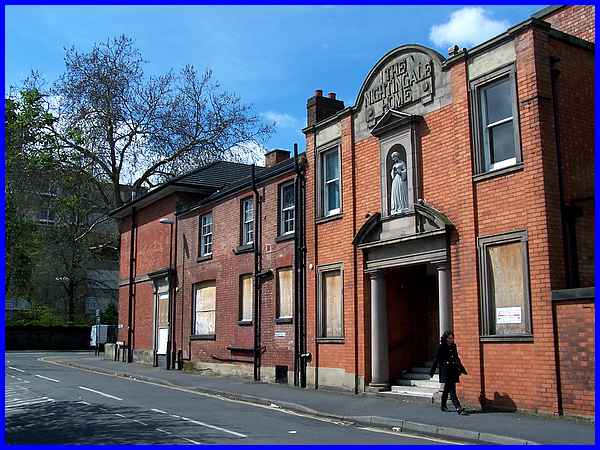
Although the Nightingale Home is now closed the main entrance
with a statue of the famous "Lady with the Lamp" above
the door is situated near the road junction. A newspaper report
of November 2011 stated that "Nightingale House has been
sold by the NHS and is to be redeveloped in a multi-million-pound
scheme" but so far there are no signs of activity at the
building which has been boarded up since 2009. Thought to be
one of the first buildings in London Road it dates from the 1820s,
was designed by William Smith, the same architect responsible
for North Parade (see Part
11) and originally named Chetwynd House. It was purchased
by the trustees of the Royal Derby and Derbyshire Nursing and
Sanitary Association in 1904 and run as a private nursing and
midwifery hospital until 1948 and the formation of the NHS.
Renamed as the Nightingale Home for Maternity Cases it continued
as a maternity home until the late 1970s and then stood empty
for five years before opening its doors again in the 1980s as
a hospice for the Nightingale Macmillan Unit which has since
moved to the new Royal Derby Hospital. The front of the building
is listed which means that the statue above the door would be
preserved when refurbishment work begins either in situ or there
is an option to move it to the new hospital.
|

Facing down Trinity Street from the grounds of the former Derby
Royal Infirmary (DRI) is another statue, that of the unmistakable
figure of Queen Victoria (1819-1901). The statue has stood here
since 1925 when it was moved from its original position at The
Spot where it had been erected in 1906 and unveiled by her son
King Edward VII on 28 June in that year.
|

Queen Victoria herself had visited Derby on the 21st May 1891
to lay the Foundation Stone at the hospital and bestowed the
"Royal" title on the Derby General Infirmary at the
same time. The Infirmary had been founded in 1810 but the main
part by Young and Hall was not built until the 1890s. More buildings
have been added since but the Victorian block in a red brick
Jacobean style can still be picked out. The DRI however has ceased
to exist having merged on the site of the Derby City Hospital
to form the new Royal Derby Hospital. Some of the original DRI
buildings have now formed the London Road Community Hospital
and provide rehabilitation and intermediate care, inpatient facilities
and some outpatient services. On the same visit in 1891 Queen
Victoria also Knighted, Alfred Haslam, MP and Derby Mayor. This
took place on the platform at Derby Station. Haslam had paid
for the extensive welcoming displays along the route of the Royal
visit (and I bet the phrase "cash for honours" was
not even thought of in those days).
|

On the opposite side of London Road to the former DRI and partially
obscured by the trees that line the road, is the Assemblies of
the First Born Church. It was originally consecrated in 1836
as St George's Church and was rebuilt in 1903. By 1973 it was
Holy Trinity and was in a poor state of repair ready for demolition
when it was purchased by the Assemblies. The Assemblies had begun
in the 1960s with a small number of followers in a room in the
Normanton district of Derby from where they went on to hiring
a hall in Osmaston Road before buying an old bakery in St James
Road for their meetings. The Church now has about twenty branches
around the UK.
|
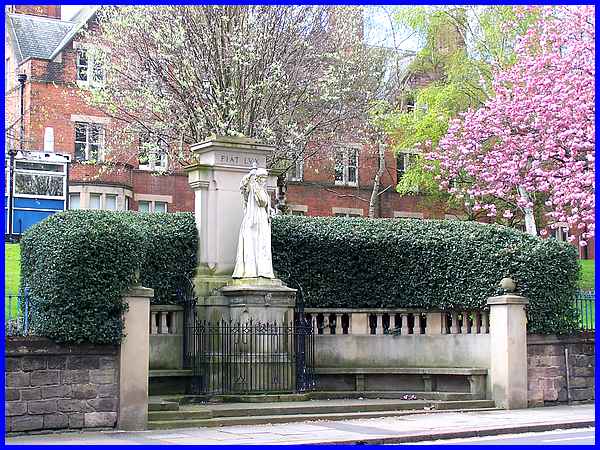
Back on the other side of the road a little further on is another
statue of Florence Nightingale. Florence, born 12 May 1820, was
named after the city where she was born in Italy, and after 1865
spent most of her life in London  although did spend some time
in Derbyshire too. She died in London aged 90 on 13 August 1910
and was buried near her parent's home in Hampshire but still
has strong ties with Derbyshire. When the family returned to
England from Italy they split their time between Embley in Hampshire
during the winter, spending the summer months in Lea Hurst, Derbyshire.
Her contribution to nursing during the Crimean War and the rest
of her life is well documented elsewhere and she received a number
of decorations and awards for her work. Her statue here in Derby
was designed by Princess Feodora v Hohenlohe-Langenburg, Countess
v Gleichen in 1911. although did spend some time
in Derbyshire too. She died in London aged 90 on 13 August 1910
and was buried near her parent's home in Hampshire but still
has strong ties with Derbyshire. When the family returned to
England from Italy they split their time between Embley in Hampshire
during the winter, spending the summer months in Lea Hurst, Derbyshire.
Her contribution to nursing during the Crimean War and the rest
of her life is well documented elsewhere and she received a number
of decorations and awards for her work. Her statue here in Derby
was designed by Princess Feodora v Hohenlohe-Langenburg, Countess
v Gleichen in 1911.
|
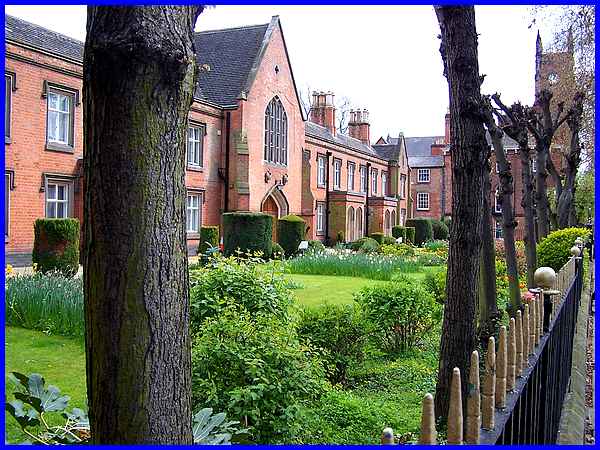
Directly across the road from the Florence Nightingale statue
is a Listed II structure called the Liversage Hospital although
the complex included thirteen almshouses, a warden's house and
a boardroom. I am not sure exactly when they where built as one
source says 1863 and another 1836 so the last two figures may
have been transposed somewhere along the line. What is undisputed
though is that the organisation responsible for the buildings
was the Liversage Charity, an ancient Derby foundation dating
from 1529. I have just discovered that the architect was John
Mason of Derby whose lifespan was between 1794 and 1847 which
seems to suggest that 1836 is the more likely date of the almshouses'
construction. The Liversage Trust is still active today and owns
over 130 properties in the social housing sector.

At first glance the continuation of the route along London Road
from the intersection of the inner ring road sees "heritage"
taking a back seat being dominated as it is by the new Westfield
shopping centre. There are one or two things worth noticing in
passing though such as the inn sign of the Royal Telegraph pub
on the corner which features an image of Queen Victoria. The
pub was built in 1937 replacing an earlier one of 1833 and has
gone by various names during its history including The Telegraph,
Trinian's and Strutts but has now reverted to The Royal Telegraph
a name the original pub adopted after a stage coach that ran
between London and Manchester. The pub stands on the corner of
London Road and Traffic Street which, if I am reading the raised
plaque on the pedestrian refuge in the middle of the road correctly,
records that Traffic Street was opened by the Rt. Hon. Sir Harry
Edward A Twyford Kt. Mayor of London on February 24th 1938. The
plaque also carries the names of Ald. E. E. Paulson J.P. (Mayor)
and Ald. W. R. Raynes J.P. (Estates Committee Chairman) plus
the names of the Town Clerk and the Borough Surveyor. With so
many dignitaries present the opening of the road must have been
a grand occasion almost set to rival the Royal visits!
Continuing across Traffic Street our route now follows
London Road by the modern lines of the Westfield Centre, a development
that it is fair to say has divided local opinion on its architectural
merit.
|
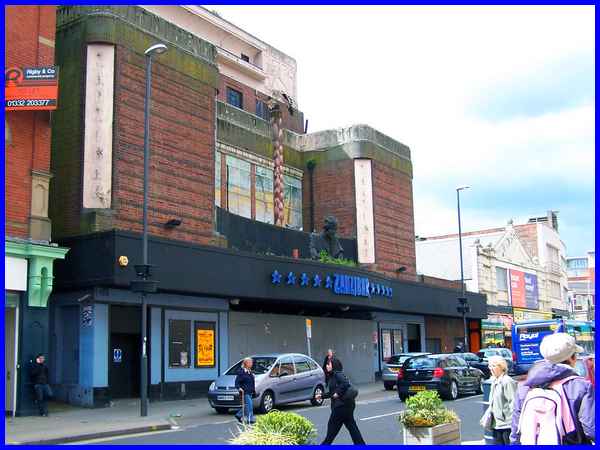
A building of a more traditional design although obviously dating
from the 1930s stands opposite the Westfield Centre near the
end of London Road. This building opened as The Gaumont Palace
cinema in 1934 and was also used as a theatre before adopting
the name of the Odeon in 1965. As part of the Rank Organisation
it suffered when multi-plex cinemas made their presence felt
and it closed in 1983 only to re-open as the New Trocadero cinema
and Bingo hall before closing again in 1988. Since then the building
has been the venue of the Zanzibar night club when the imitation
palm tree and rather garish head (hardly worthy of the word "statue")
were surprisingly allowed by the planning authorities to be added
to the façade but currently it once again stands unused.
Personal note: It was here in the mid 1960s that I saw Adam
Faith and The Roulettes top the bill with The Searchers being
the support act during a one night stand tour of the UK. Suffice
it to say that a below par Searchers set to close to first half
led to what can only be described as a less than enthusiastic
reception whilst the second half opened by The Roulettes and
closed by Adam Faith left the audience screaming for more! I
suppose in this Heritage Walk around Derby, that's part of my
own personal heritage.
|
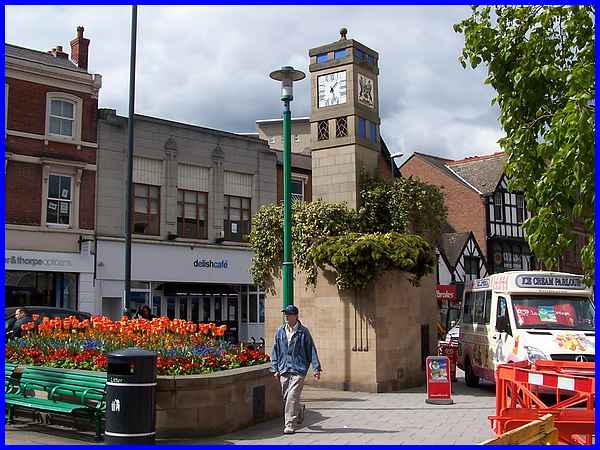
  London Road meets Osmaston Road and St Peter's
Street at The Spot which is where the statue of Queen Victoria
that we saw earlier stood between 1906 and 1925. It was unveiled
here by King Edward VII on 28th June 1906. Redevelopment of The
Spot in 1993 included the installation of a clock tower which
now forms a focal point and also marks the place where we will
begin Part 29 of this series. London Road meets Osmaston Road and St Peter's
Street at The Spot which is where the statue of Queen Victoria
that we saw earlier stood between 1906 and 1925. It was unveiled
here by King Edward VII on 28th June 1906. Redevelopment of The
Spot in 1993 included the installation of a clock tower which
now forms a focal point and also marks the place where we will
begin Part 29 of this series.
|

